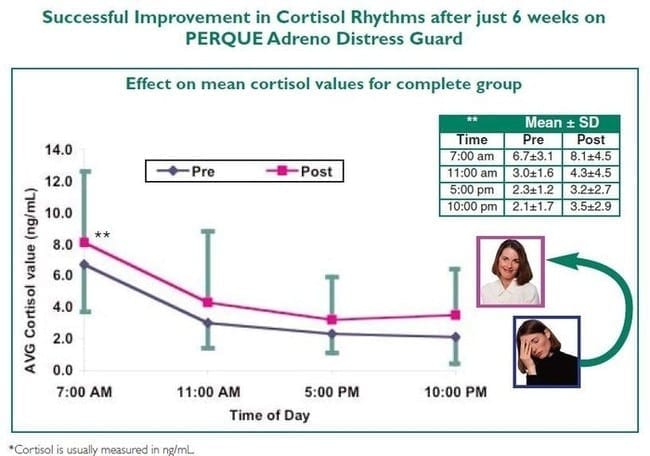Forty-three percent of all adults suffer adverse health effects from stress.
While some stress can be helpful, keeping us alert and resilient, chronic stress can cause inflammation and disease, putting our overall health at risk. Reducing the burden of stress in our lives is necessary for sustained health. In this article, we will explore the relationship between stress and adrenal health.
What happens when you are under stress?
No matter the source of the stress — whether infectious, nutritional, emotional or physical — the body responds in the same way: by increasing the production of stress hormones. These chemical messengers act on different systems to tell the body to prepare for action by:
– Raising blood pressure
– Increasing heart rate
– Improving mental alertness (which can cause anxiety), and
– Increasing the energy supply
Where do these stress hormones come from?
The adrenal gland is responsible for the body’s hormonal response to stress. The adrenal medulla (inside portion of the gland) produces adrenaline, which stimulates the instant stress hormone response (fight or flight reaction).
The adrenal cortex (outer portion of the gland) produces, among other things, cortisol and DHEA, which create the short- and long-term stress hormone responses.
Cortisol suppresses the immune system, breaks down tissues and has a generally catabolic effect [breaks large molecules into smaller ones to release energy].
These effects are balanced out by DHEA, which has the opposite effect – activating the immune system and building up tissues.
What happens to cortisol and DHEA when I’m under stress?
Under stress, the body’s normal response is to increase cortisol production. This increased output of stress hormones is essential for managing short-term stress, but is unsustainable over the long term. Following a short-term stress event, the adrenal glands can rest and recover. But when stress is ongoing, unremitting and unrelenting, the body remains in a constant state of alert, and “adrenal fatigue” eventually sets in. The output of the adrenal gland decreases, making the body far less able to tolerate additional stress. Over time, adrenal function declines, gradually leading to failure.
This is the spectrum of adrenal functioning that can be measured and observed:
– Normal levels of cortisol and normal DHEA: This is a normal result, and indicates that the adrenal gland is functioning properly.
– Elevated cortisol and normal DHEA. This result indicates a normal short-term response to stress.
– Elevated cortisol and elevated DHEA. This result indicates that the adrenal gland is functioning normally but the patient is chronically stressed. As long as the stress is removed, the adrenal gland will recover completely.
– Elevated levels of cortisol and low levels of DHEA. This result indicates that the body cannot make enough DHEA to balance the amount of cortisol being produced in response to stress. This is the first sign of adrenal exhaustion, and the first abnormal response to chronic stress. It’s important to seek the source of the long-standing stress, and take steps to remove it. The most common chronic stressor is hypoglycemia, but also consider insomnia; mental, physical or emotional overload; and other precipitating life events. DHEA supplementation (under medical supervision), may help balance the system and help the patient to feel better.
– Low cortisol levels low and low DHEA levels. This result indicates that the adrenal gland is so exhausted it can’t make cortisol or DHEA. By this time, patients are usually severely fatigued.
– Low cortisol levels and borderline or normal DHEA levels. This result most likely indicates that the adrenal gland is beginning to recover after a long rest. DHEA may be used to help patients feel better while they continue their program of rest and rehabilitation.
How can I tell if my system is functioning optimally?
There’s an adrenal stress test that looks at cortisol and DHEA levels over four time points during the day through a salivary sample. This easy test is an accurate way of assessing adrenal hormone levels.
(NOTE: Addison’s disease is a fairly uncommon (1 in 10,000) autoimmune disease that affects the adrenal gland and causes it to fail. It should be ruled out when test results indicate complete failure of the gland.)
What can I do if my cortisol and DHEA are out of balance?
The most important step toward adrenal health is reducing chronic stressors and increasing restful sleep. In mild to moderate cases of adrenal fatigue, results may be seen from diet and lifestyle changes aimed at reducing stress. Stress reduction tools including moderate exercise and learned relaxation techniques such meditation, yoga, tai chi, or Pilates are good ways to naturally rest and restore your adrenals. Reducing carbs and stimulants, and better meeting modern day nutrient needs with high-quality dietary supplements are also important in restoring adrenal balance. Additionally, certain herbal supplements have been shown to be particularly helpful in balancing cortisol and DHEA.
Magnolia (Magnolia officinalis) and Phellodendron (Phellodendron amurense) barks are medicinal plants that have been used for centuries as traditional remedies for stress and anxiety. Both herbs have a calming effect on the body, without the sedating effects seen with pharmaceutical agents. Combined, they have been shown to be more effective in controlling stress/anxiety, than either herb alone. In a recent four-week study of 56 participants with moderate stress, the combination significantly decreased cortisol levels, perceived stress, and fatigue; and participants reported better mood and “vigor.”
Rhodiola rosea is a popular plant in traditional medical systems in Eastern Europe and Asia and works on harmonizing the central nervous system, decreasing depression, enhancing work performance, eliminating fatigue, stabilizing moods, as well as working as a healthy mood regulator. Rhodiola rosea has action in both the central and peripheral nervous systems, affecting both monoamines (adrenalines, serotonin, dopamine, etc.) and opioid peptides such as beta-endorphins in the body. In addition, rhodiola rosea modulates cortisol production in times of physical or emotional stress. A term for this balancing effect is “adaptogenic” – meaning the compound helps restore the body to homeostasis.
PERQUE Adreno Distress Guard™ is a unique combination of Rhodiola (Rosavins), Magnolia and Phellodendron plant extracts, in their most active, safe and effective forms. In this advanced formulation, the plant extracts are micellized into perilla oil, and Medium Chain Triglycerides to achieve maximum absorption and efficacy in supporting a healthier balance of adrenal hormones.
In a six-week community assessment of people with signs and symptoms of adrenal fatigue, participants taking PERQUE Adreno Distress Guard, a novel formulation combining Rhodiola (Rosavins), Magnolia and Phellodendron, saw substantial improvement in cortisol levels.
In the assessment, 24 people with clinical signs and symptoms of adrenal fatigue were given pre- and post-evaluations of free cortisol and DHEA levels using non-invasive, saliva samples known to correlate with free blood (plasma) hormone levels.
It was found that after just six weeks of supplementation with PERQUE Adreno Distress Guard, first morning cortisol levels significantly increased from a depressed value of 6.7 ng/mL to a much healthier 8.1ng/mL, and normal cortisol rhythm was restored. In a small number of cases with abnormally high morning cortisol, six weeks of supplementation resulted in a lowering to more normal levels.

Did you enjoy this post? We post new content regularly! Click here to see our latest blog posts.


